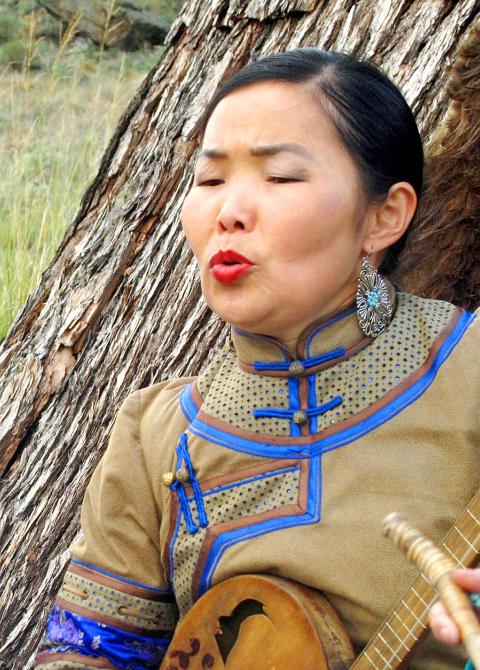The tiny Russian republic of Tuva, located in Siberia just north of Mongolia, will be the focus at Taipei’s Red Room this weekend. The three-day event kicks into high gear tonight with a concert featuring Tuva’s trademark throat singing along with both local and foreign talent.
The visiting throat singer — who can produce two or more tones simultaneously — is Choduraa Tumat, founder of an all-female folk ensemble who also plays the Jew’s harp and horse-head fiddle. She will share the stage with Atayal Aboriginal singer and dancer Pisui Ciyo, Paiwan Aboriginal double nose flute player Sauniaw, Mexican percussionist Ivan Alberto and Dutch performance artist and Siberian music expert Mark van Tongeren.
Tomorrow’s program, “A Touch of Tuva,” will focus on culture as Choduraa Tumat and others will be introducing the music, film, food, drink and even smells of the Tuvan grasslands and taiga. And finally, those who want to try throat singing can participate in workshops on Sunday.

Photo courtesy of Red Room
■ Tonight’s concert is from 7:30pm to 9:30pm at the Red Room, Taiwan Air Force Innovation Base (TAF 空總創新基地), 177, Sec 1, Jianguo S Rd, Taipei City (台北市建國南路一段177號). Tomorrow’s event is from 2pm to 6pm, also at the Red Room. The workshops are 10am to 1pm for beginners and 2pm to 5pm for advanced students at the Canjune Training Center, 4F, 3, Ln 151, Fuxing S Rd Sec 2, Taipei City (台北市復興南路151巷3號4樓)
■ Admission is NT$600 for tonight’s concert, tomorrow’s program is free. The workshops are NT$2,500 for each half day. Registration is required. Visit www.fusica.nl/a-touch-of-tuva-in-taipei for more details in both English and Chinese.

June 23 to June 29 After capturing the walled city of Hsinchu on June 22, 1895, the Japanese hoped to quickly push south and seize control of Taiwan’s entire west coast — but their advance was stalled for more than a month. Not only did local Hakka fighters continue to cause them headaches, resistance forces even attempted to retake the city three times. “We had planned to occupy Anping (Tainan) and Takao (Kaohsiung) as soon as possible, but ever since we took Hsinchu, nearby bandits proclaiming to be ‘righteous people’ (義民) have been destroying train tracks and electrical cables, and gathering in villages

Swooping low over the banks of a Nile River tributary, an aid flight run by retired American military officers released a stream of food-stuffed sacks over a town emptied by fighting in South Sudan, a country wracked by conflict. Last week’s air drop was the latest in a controversial development — private contracting firms led by former US intelligence officers and military veterans delivering aid to some of the world’s deadliest conflict zones, in operations organized with governments that are combatants in the conflicts. The moves are roiling the global aid community, which warns of a more militarized, politicized and profit-seeking trend

The wide-screen spectacle of Formula One gets a gleaming, rip-roaring workout in Joseph Kosinski’s F1, a fine-tuned machine of a movie that, in its most riveting racing scenes, approaches a kind of high-speed splendor. Kosinski, who last endeavored to put moviegoers in the seat of a fighter jet in Top Gun: Maverick, has moved to the open cockpits of Formula One with much the same affection, if not outright need, for speed. A lot of the same team is back. Jerry Bruckheimer produces. Ehren Kruger, a co-writer on Maverick, takes sole credit here. Hans Zimmer, a co-composer previously, supplies the thumping

Dr. Y. Tony Yang, Associate Dean of Health Policy and Population Science at George Washington University, argued last week in a piece for the Taipei Times about former president Ma Ying-jeou (馬英九) leading a student delegation to the People’s Republic of China (PRC) that, “The real question is not whether Ma’s visit helps or hurts Taiwan — it is why Taiwan lacks a sophisticated, multi-track approach to one of the most complex geopolitical relationships in the world” (“Ma’s Visit, DPP’s Blind Spot,” June 18, page 8). Yang contends that the Democratic Progressive Party (DPP) has a blind spot: “By treating any